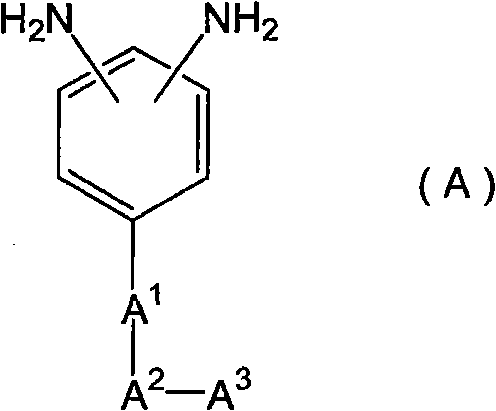Liquid crystal alignment agent and liquid crystal display element
A technology of liquid crystal display element and liquid crystal aligning agent, which is applied in the direction of liquid crystal materials, chemical instruments and methods, optics, etc., can solve the problems of increased level difference, and achieve the effect of excellent printability and beautiful display
- Summary
- Abstract
- Description
- Claims
- Application Information
AI Technical Summary
Problems solved by technology
Method used
Image
Examples
Synthetic example 1
[0135] Synthesis example 1 (synthesis of imidized polymer (A-1))
[0136] 125 g (0.50 moles) of 3,5,6-tricarboxy-2-carboxymethylnorbornane-2:3,5:6-dianhydride as tetracarboxylic dianhydride, p-phenylenediamine as diamine 53 g (0.49 mol) and 5.2 g (0.01 mol) of cholestanyl 3,5-diaminobenzoate were dissolved in 830 g of N-methyl-2-pyrrolidone and reacted at 60° C. for 6 hours. Take a small amount of the obtained polyamic acid solution and add N-methyl-2-pyrrolidone to form a solution with a polyamic acid concentration of 10% by weight. The measured solution viscosity is 50 mPa·s.
[0137] Then, 1900 g of γ-butyrolactone was added to the obtained polyamic acid solution, 80 g of pyridine and 100 g of acetic anhydride were added, and a dehydration ring-closure reaction was performed at 110° C. for 4 hours. After the dehydration ring-closure reaction, the solvent in the system is replaced with new N-methyl-2-pyrrolidone (by this solvent replacement operation, the pyridine and aceti...
Synthetic example 2
[0138] Synthesis example 2 (synthesis of polyamic acid (A-2))
[0139] 188 g (0.75 moles) of 3,5,6-tricarboxy-2-carboxymethylnorbornane-2:3,5:6-dianhydride as tetracarboxylic dianhydride and 1,2,3,4- Cyclobutanetetracarboxylic dianhydride 49g (0.25 mole), as diamine 4,4'-diaminodiphenyl ether 190g (0.95 mole) and 3,5-diaminobenzoic acid cholestenyl ester 26g ( 0.05 mole) was dissolved in the mixed solvent that is made up of 410g N-methyl-2-pyrrolidone and 3730g gamma-butyrolactone, reacted 4 hours at 40 ℃, obtain about 4500g containing 10% by weight polyamic acid (A-2) The solution. The solution viscosity of this polyamic acid solution was 43 mPa·s.
Synthetic example 3
[0140] Synthesis example 3 (synthesis of imidized polymer (A-3))
[0141] 25 g (0.1 mol) of 3,5,6-tricarboxy-2-carboxymethylnorbornane-2:3,5:6-dianhydride as tetracarboxylic dianhydride and 2,3,5-tricarboxy Cyclopentyl acetic acid dianhydride 90g (0.4 mole), as diamine p-phenylenediamine 43g (0.40 mole) and 1-cholestalkoxy-2,4-diaminobenzene 49g (0.10 mole) is dissolved in 830g N -Methyl-2-pyrrolidone was reacted at 60° C. for 6 hours. Take a small amount of the obtained polyamic acid solution and add N-methyl-2-pyrrolidone to form a solution with a polyamic acid concentration of 10% by weight. The measured solution viscosity is 55 mPa·s.
[0142] Then, 1900 g of N-methyl-2-pyrrolidone was added to the obtained polyamic acid solution, and 40 g of pyridine and 51 g of acetic anhydride were added, and a dehydration ring-closing reaction was performed at 110° C. for 4 hours. After the dehydration ring-closing reaction, the solvent in the system is replaced by a new N-methyl-2-p...
PUM
| Property | Measurement | Unit |
|---|---|---|
| Viscosity | aaaaa | aaaaa |
| Solution viscosity | aaaaa | aaaaa |
| Viscosity | aaaaa | aaaaa |
Abstract
Description
Claims
Application Information
 Login to View More
Login to View More - R&D
- Intellectual Property
- Life Sciences
- Materials
- Tech Scout
- Unparalleled Data Quality
- Higher Quality Content
- 60% Fewer Hallucinations
Browse by: Latest US Patents, China's latest patents, Technical Efficacy Thesaurus, Application Domain, Technology Topic, Popular Technical Reports.
© 2025 PatSnap. All rights reserved.Legal|Privacy policy|Modern Slavery Act Transparency Statement|Sitemap|About US| Contact US: help@patsnap.com



